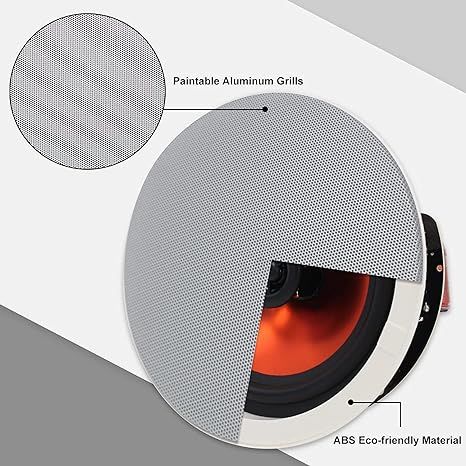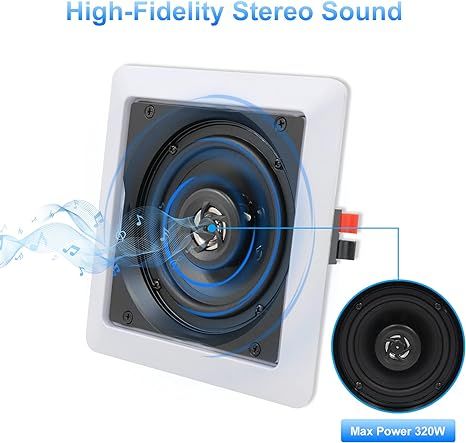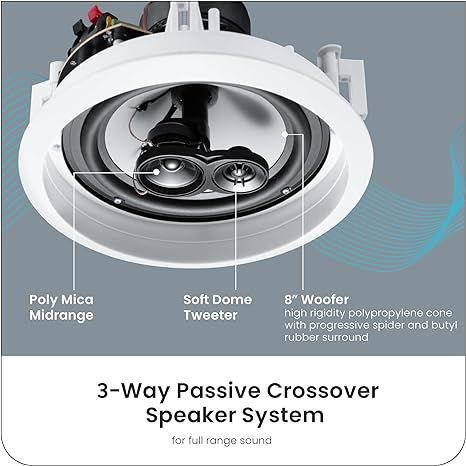Unlock Perfect Bass: The Ultimate Guide to the Subwoofer Crawl
- How to Perform the Subwoofer Crawl (Step-by-Step)
- Tips for Better Results
- How Room Acoustics Affect Bass
- The Science Behind the Subwoofer Crawl
- Subwoofer Crawl vs. Auto EQ Systems
- 10 Best Subwoofers for Deep, Clean Bass
- Table 1. Overview of Top Subwoofers
- Table 2. Pros and Cons
- Table 3. Customer Ratings (Amazon)
- Table 4. Best by Category
- Real User Reviews
- Subwoofer Crawl Optimization by Room Type
- Common Mistakes During the Subwoofer Crawl
- How to Use Measurement Tools After the Crawl
- Multi-Subwoofer Strategy
- Fine-Tuning After Placement
- Conclusion
The Subwoofer Crawl is an audiophile technique that flips the usual placement process. Instead of placing the subwoofer first and testing different listening positions, you start by placing the subwoofer in your listening position, then move around the room to find where the bass sounds best.
It's based on the principle of acoustic reciprocity, meaning that the path sound travels from speaker to listener behaves the same in reverse. This allows you to "listen" for optimal spots from the sub's perspective.
How to Perform the Subwoofer Crawl (Step-by-Step)
| Step | Description |
|---|---|
| 1. Place Subwoofer in Listening Position | Put your subwoofer where you usually sit - on your chair or sofa. |
| 2. Play a Bass-Heavy Track or Test Tone | Use deep, consistent bass frequencies between 30-80 Hz. |
| 3. Crawl Around the Room | Move on your hands and knees around the perimeter of the room, especially along walls and corners. |
| 4. Listen Carefully | Stop at each spot where bass sounds even, full, and natural - not boomy or hollow. |
| 5. Mark the Sweet Spots | Identify one or two positions that sound the most balanced. |
| 6. Move Subwoofer to Best Spot | Place your subwoofer in the marked location and re-test. |
Tips for Better Results
-
Use familiar music: Choose tracks with consistent, deep bass (like electronic or orchestral pieces).
-
Avoid corners initially: Corners amplify bass but can distort it.
-
Test multiple seating positions: Especially in multi-row home theaters.
-
Fine-tune with crossover and phase controls: Once placed, adjust your subwoofer's controls for seamless integration with your main speakers.
How Room Acoustics Affect Bass
| Room Factor | Impact on Bass | Recommendation |
|---|---|---|
| Room Size | Larger rooms need more power or multiple subs | Choose higher-wattage models |
| Flooring Type | Hard surfaces reflect bass | Use rugs or bass traps |
| Furniture | Can absorb or block sound | Keep path between sub and listener clear |
| Walls & Corners | Reflect bass energy | Use placement 1-2 feet away from walls |
Proper acoustics combined with the Subwoofer Crawl method can dramatically improve your overall soundstage.
The Science Behind the Subwoofer Crawl
Sound waves bounce off surfaces and create interference patterns. At certain frequencies, constructive interference increases bass (peaks), while destructive interference cancels it out (nulls).
By moving around during the crawl, you're essentially mapping these areas and identifying where your room supports natural bass reinforcement.
Subwoofer Crawl vs. Auto EQ Systems
| Feature | Subwoofer Crawl | Auto EQ (Room Correction) |
|---|---|---|
| Cost | Free | Requires built-in DSP or AV receiver |
| Accuracy | Based on human hearing | Based on microphone readings |
| Setup Time | 10-15 minutes | 20-30 minutes |
| Flexibility | Works in any room | Limited by algorithm |
| Best Use | Manual tuning | Fine-tuning after crawl |
Combining both methods offers the best of both worlds - use the crawl for placement, and Auto EQ for final calibration.
10 Best Subwoofers for Deep, Clean Bass
Here's a comparison of the top-rated subwoofers for home theater and music listening. Each model is chosen for performance, reliability, and user satisfaction.
Table 1. Overview of Top Subwoofers
| Rank | Model | Type | Power Output | Price (Amazon) |
|---|---|---|---|---|
| 1 | SVS SB-1000 Pro | Sealed | 325W RMS / 820W Peak | $599 |
| 2 | Klipsch R-120SW | Ported | 200W RMS / 400W Peak | $299 |
| 3 | Polk Audio HTS 12 | Ported | 200W RMS / 400W Peak | $349 |
| 4 | Yamaha NS-SW300PN | Ported | 250W RMS | $399 |
| 5 | Monoprice Monolith 10" THX | Sealed | 500W RMS / 900W Peak | $549 |
| 6 | Definitive Technology SuperCube 4000 | Compact | 1200W Peak | $899 |
| 7 | BIC Acoustech PL-200 II | Ported | 250W RMS / 1000W Peak | $449 |
| 8 | ELAC SUB3030 | App-Controlled | 500W Peak | $679 |
| 9 | JBL Stage A120P | Ported | 250W RMS | $399 |
| 10 | Sony SA-SW5 Wireless | Wireless | 300W RMS | $699 |
Table 2. Pros and Cons
| Model | Pros | Cons |
|---|---|---|
| SVS SB-1000 Pro | Tight, accurate bass; app control | Slightly expensive for small rooms |
| Klipsch R-120SW | Powerful low-end punch | Can sound boomy in corners |
| Polk HTS 12 | Excellent value, modern design | Needs space for best performance |
| Yamaha NS-SW300PN | Precise sound, reliable build | Moderate deep-bass extension |
| Monoprice Monolith 10" | THX certified, deep extension | Heavy and bulky |
| Definitive Tech SuperCube | Huge power in compact design | Premium price |
| BIC Acoustech PL-200 II | Incredible value for money | Slight distortion at max output |
| ELAC SUB3030 | App tuning, strong mid-bass | App setup may be complex |
| JBL Stage A120P | Smooth, consistent sound | Not ideal for very large rooms |
| Sony SA-SW5 | Wireless convenience | Works only with Sony soundbars |
Table 3. Customer Ratings (Amazon)
| Model | Rating (Out of 5) | Customer Feedback Summary |
|---|---|---|
| SVS SB-1000 Pro | 4.9 | "Clean, musical bass - perfect for both music and movies." |
| Klipsch R-120SW | 4.7 | "Room-filling low-end, great value." |
| Polk HTS 12 | 4.6 | "Tight bass, impressive design." |
| Yamaha NS-SW300PN | 4.5 | "Reliable and balanced sound." |
| Monoprice Monolith 10" | 4.8 | "Deep and cinematic bass; worth every dollar." |
| Definitive SuperCube 4000 | 4.8 | "Compact powerhouse - bass hits hard." |
| BIC PL-200 II | 4.7 | "Affordable sub that shakes the room." |
| ELAC SUB3030 | 4.6 | "Love the app control and adjustability." |
| JBL Stage A120P | 4.6 | "Solid performance for its price." |
| Sony SA-SW5 | 4.7 | "Works seamlessly with Sony setup, clean output." |
Table 4. Best by Category
| Category | Model | Why It Stands Out |
|---|---|---|
| Best Overall | SVS SB-1000 Pro | Excellent control, low distortion |
| Best Value | Klipsch R-120SW | Affordable and powerful |
| Best for Movies | Monoprice Monolith 10" | Theater-grade bass |
| Best for Music | Yamaha NS-SW300PN | Detailed, tight sound |
| Best Compact Sub | Definitive SuperCube 4000 | Big performance, small size |
| Best Budget Option | BIC Acoustech PL-200 II | Exceptional output for price |
| Best Wireless | Sony SA-SW5 | Hassle-free integration |
| Best App Control | ELAC SUB3030 | Customizable tuning |
| Best for Style | Polk HTS 12 | Elegant design and great sound |
| Editor's Choice | SVS SB-1000 Pro | Balanced for all listening types |
Real User Reviews
-
SVS SB-1000 Pro: "I didn't realize what real bass was until I bought this. Clean, deep, and powerful."
-
Monoprice Monolith: "Rattles the walls without distortion. True cinema experience."
-
Klipsch R-120SW: "Great punch and perfect for my medium-sized living room."
-
Definitive SuperCube: "Tiny box, massive sound. Worth the premium."
-
BIC PL-200 II: "Budget-friendly beast. Feels like a sub twice the price."
Subwoofer Crawl Optimization by Room Type
| Room Type | Recommended Subwoofer Type | Placement Tip |
|---|---|---|
| Small Bedroom (<200 sq. ft.) | Sealed subwoofer | Place 1 ft from wall |
| Medium Living Room (200-400 sq. ft.) | Ported subwoofer | Avoid corners; ⅓ distance from wall |
| Large Home Theater (400+ sq. ft.) | Dual subs (sealed or ported) | Opposite walls or diagonal corners |
| Open-Concept Room | Ported with DSP control | Use Auto EQ after crawl |
| Apartment Setup | Compact sealed sub | Keep gain low to reduce wall vibration |
Common Mistakes During the Subwoofer Crawl
-
Using short test tracks: You need sustained low frequencies to identify true hotspots.
-
Crawling too fast: Give your ears time to detect small differences.
-
Ignoring furniture: Large items absorb or reflect bass.
-
Placing sub near doorways: Causes inconsistent bass pressure.
-
Forgetting phase adjustment: Misalignment with main speakers causes cancellation.
How to Use Measurement Tools After the Crawl
Once you've found the best physical location using the crawl, you can fine-tune further with:
-
Room EQ Wizard (REW) - free acoustic analysis software.
-
Sound Pressure Meter - ensures consistent levels.
-
AV Receiver Auto Calibration (Audyssey, YPAO, Dirac Live) - for final equalization.
Multi-Subwoofer Strategy
For large or irregular rooms, multiple subwoofers can smooth out response.
| Setup | Description | Benefit |
|---|---|---|
| Dual Front Corners | One on each front corner | Even front soundstage |
| Diagonal Corners | Opposite corners | Balanced bass across room |
| Mid-Wall Placement | Center of opposite walls | Reduces peaks and nulls |
Adding a second sub doesn't just make it louder - it makes it more consistent.
Fine-Tuning After Placement
-
Crossover: Set 80 Hz for most systems (or 10 Hz above speaker's low limit).
-
Phase: Adjust for maximum bass at listening position.
-
Gain: Match subwoofer volume to main speakers.
-
Room Treatments: Add bass traps or diffusers for best results.
Conclusion
The Subwoofer Crawl is one of the most powerful and cost-free tools for improving your audio experience. No matter how expensive your system is, poor placement can ruin your bass response. By simply reversing the setup process - starting from your listening position - you can unlock deeper, cleaner, and more accurate low frequencies.
Pair this technique with one of the top 10 subwoofers listed above, and you'll experience the kind of immersive sound that makes music and movies come alive. Whether you're a casual listener or a hardcore audiophile, perfecting your bass is the final step in achieving true sonic perfection.







